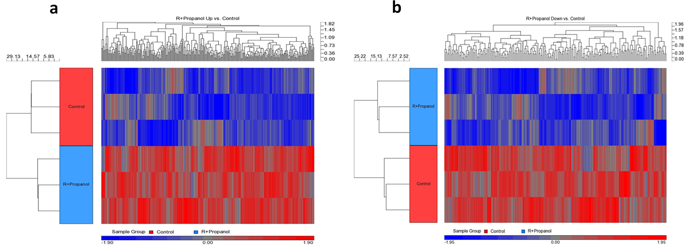npj Precision Oncology ( IF 6.8 ) Pub Date : 2019-11-01 , DOI: 10.1038/s41698-019-0099-9 Maiko Sasaki , Paula E. North , Justin Elsey , Jeffrey Bubley , Shikha Rao , Yoonhee Jung , Shengnan Wu , Ming-Hui Zou , Brian P. Pollack , Jayanth Kumar , Hartej Singh , Jack L. Arbiser

|
Propranolol is a widely used beta blocker that consists of a racemic mixture of R and S stereoisomers. Only the S stereoisomer has significant activity against the beta-adrenergic receptor. A fortuitous clinical observation was made in an infant who received propranolol for cardiac disease, and regression of a hemangioma of infancy was noted. This has led to the widespread use of propranolol for the treatment of large and life-threatening hemangiomas of infancy. Infants receiving propranolol require monitoring to ensure that they do not suffer from side effects related to beta blockade. The exact mechanism of activity of propranolol in hemangioma of infancy is unknown. In this study, we treated hemangioma stem cells with both beta blockade active S- and inactive R-propranolol and looked for genes that were coordinately regulated by this treatment. Among the genes commonly downregulated, Angiopoietin-like 4 (ANGPTL4) was among the most regulated. We confirmed that propranolol isomers downregulated ANGPTL4 in endothelial cells, with greater downregulation of ANGPTL4 using the beta blockade inactive R-propranolol. ANGPTL4 is present in human hemangiomas of infancy. Finally, R-propranolol inhibited the growth of bEnd.3 hemangioma cells in vivo. The implication of this is that hemangioma growth can be blocked without the side effects of beta blockade. Given that humans have been exposed to racemic propranolol for decades and thus to R-propranolol, clinical development of R-propranolol for hemangiomas of infancy and other angiogenic diseases is warranted.
中文翻译:

普萘洛尔对血管瘤表现出独立于β受体阻滞剂的活性
普萘洛尔是一种广泛使用的β受体阻滞剂,由R和S立体异构体的外消旋混合物组成。仅S立体异构体对β-肾上腺素受体具有显着的活性。在接受普萘洛尔治疗心脏病的婴儿中进行了偶然的临床观察,并观察到婴儿血管瘤消退。这导致了普萘洛尔广泛用于治疗大型且威胁生命的婴儿血管瘤。接受普萘洛尔的婴儿需要进行监测以确保他们不会遭受与β受体阻滞有关的副作用。普萘洛尔在婴儿血管瘤中活动的确切机制尚不清楚。在这项研究中,我们用β阻断活性S-和无活性R-心得安治疗血管瘤干细胞,并寻找受此治疗协同调节的基因。在通常被下调的基因中,血管生成素样4(ANGPTL4)是最受调节的基因之一。我们证实,普萘洛尔异构体在内皮细胞中下调ANGPTL4,而使用β受体阻滞性R-普萘洛尔则对ANGPTL4的下调作用更大。ANGPTL4存在于婴儿的人类血管瘤中。最后,R-普萘洛尔在体内抑制bEnd.3血管瘤细胞的生长。这意味着血管瘤的生长可以被阻止,而不会产生β受体阻滞的副作用。考虑到人类已经暴露于外消旋普萘洛尔数十年,从而暴露于R-普萘洛尔,因此有必要对R-普萘洛尔用于婴儿血管瘤和其他血管生成性疾病的临床开发。我们证实,普萘洛尔异构体在内皮细胞中下调ANGPTL4,而使用β受体阻滞性R-普萘洛尔则对ANGPTL4的下调作用更大。ANGPTL4存在于婴儿的人类血管瘤中。最后,R-普萘洛尔在体内抑制bEnd.3血管瘤细胞的生长。这意味着血管瘤的生长可以被阻止,而不会产生β受体阻滞的副作用。考虑到人类已经暴露于外消旋普萘洛尔数十年,从而暴露于R-普萘洛尔,因此有必要对R-普萘洛尔用于婴儿血管瘤和其他血管生成性疾病的临床开发。我们证实,普萘洛尔异构体在内皮细胞中下调ANGPTL4,而使用β受体阻滞性R-普萘洛尔则对ANGPTL4的下调作用更大。ANGPTL4存在于婴儿的人类血管瘤中。最后,R-普萘洛尔在体内抑制bEnd.3血管瘤细胞的生长。这意味着血管瘤的生长可以被阻止,而不会产生β受体阻滞的副作用。考虑到人类已经暴露于外消旋普萘洛尔数十年,从而暴露于R-普萘洛尔,因此有必要对R-普萘洛尔用于婴儿血管瘤和其他血管生成性疾病的临床开发。体内有3个血管瘤细胞。这意味着血管瘤的生长可以被阻止,而不会产生β受体阻滞的副作用。考虑到人类已经暴露于外消旋普萘洛尔数十年,从而暴露于R-普萘洛尔,因此有必要对R-普萘洛尔用于婴儿血管瘤和其他血管生成性疾病的临床开发。体内有3个血管瘤细胞。这意味着血管瘤的生长可以被阻止,而不会产生β受体阻滞的副作用。考虑到人类已经暴露于外消旋普萘洛尔数十年,从而暴露于R-普萘洛尔,因此有必要对R-普萘洛尔用于婴儿血管瘤和其他血管生成性疾病的临床开发。











































 京公网安备 11010802027423号
京公网安备 11010802027423号